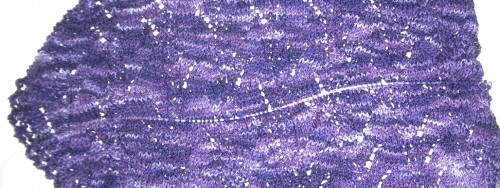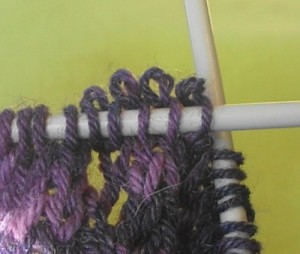This beautiful lace shawl is knit in a wonderfully soft, slow striping Mochi Plus yarn. The rectangle design means no shaping so the simple lace pattern is easy to work and it is knit in the lengthwise direction.
Sizes:
Prior to blocking: 67" wide x 20" long
After blocking: 70" wide x 22" long
Gauge:
3.5 sts=1" in St st
Materials:
Crystal Palace Bamboo 35" Circular Size 11 US (8 mm)
8-50 gr balls Crystal Palace Yarns Mochi Plus #553 Violets Rainbow
Instructions
CO 238 sts.
K 2 rows, slipping first st of every row.
Begin pattern Rows 1-12 below, slipping first st, k the next two sts, work pattern to last 3 sts, k3 every row.
Row 1 (WS) and all WS Rows: Purl.
Row 2: K2tog, *k5, yo, k1, yo, k2, sl 1, k2tog, psso; rep from *, end last repeat ssk instead of sl 1, k2tog, psso.
Row 4: K2tog, *k4, yo, k3, yo, k1, sl 1, k2tog, psso; rep from *, end last repeat ssk instead of sl 1, k2tog, psso.
Row 6: K2tog, *k3, yo, k5, yo, sl 1, k2tog, psso; rep from *, end last repeat ssk instead of sl 1, k2tog, psso.
Row 8: K2tog, *k2, yo, k1, yo, k5, sl 1, k2tog, psso; rep from *, end last repeat ssk instead of sl 1, k2tog, psso.
Row 10: K2tog, *k1, yo, k3, yo, k4, sl 1, k2tog, psso; rep from *, end last repeat ssk instead of sl 1, k2tog, psso.
Row 12: K2tog, * yo, k5, yo, k3, sl 1, k2tog, psso; rep from *, end last repeat ssk instead of sl 1, k2tog, psso.
Rep Rows 1-12 6 more times; stole should measure about 20" long.
P 2 rows.
BO knitwise loosely.
Block.
Designed by Barbara Breiter - visit her site for many more patterns - www.knitabit.net
Crystal Palace Yarns 160 23rd St, Richmond, CA 94804
phone: 510-237-9988, fax: 510-237-9809 email: cpyinfo -@- straw.com
copyright 2009 Crystal Palace Yarns/Straw Into Gold, Inc. - We are happy to share this free knitting pattern with knitters. The pattern may be used for non-commercial personal or knitting guild use. It is not to be used in any publication in print nor should it be reproduced in electronic/digital format or elsewhere on the Web without permission. Knitting shops carrying CP Yarns Mochi Plus are welcome to print and share this pattern with customers of our yarns.








